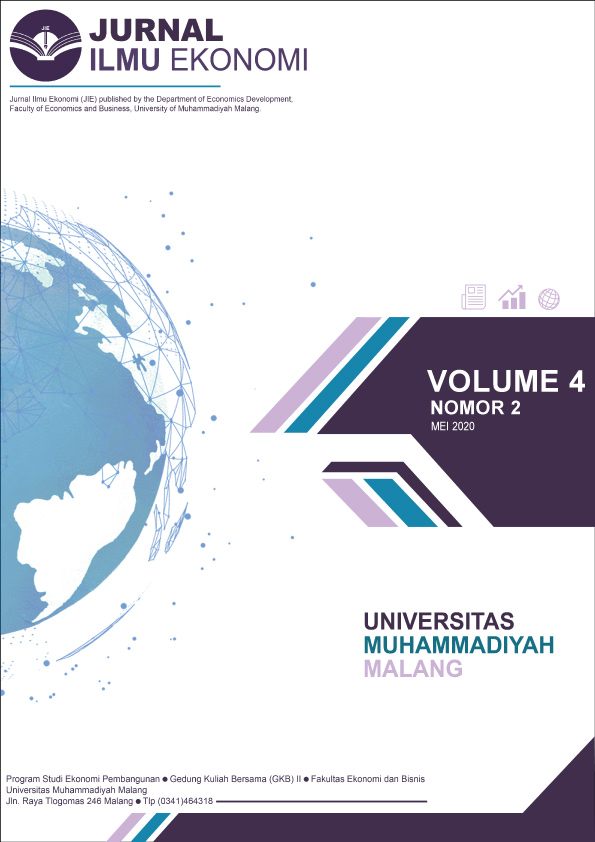ANALISIS KESETARAAN GENDER TERHADAP KEPUTUSAN INVESTASI SAHAM DI DANAREKSA SEKURITAS
DOI:
https://doi.org/10.22219/jie.v4i2.11626Keywords:
intuition, financial analysis, financial literacy, confidence, stock investment decisions.Abstract
This study was conducted to analyze gender equality in stock investment decisions in Danareksa Securities, which are measured using financial factors (financial analysis and financial literacy) and non-financial factors (self-confidence and intuition) as independent variables and stock investment decisions as independent variables. This research uses a quantitative descriptive method. This research is conducted to study certain objects by distributing questionnaires which are then interpreted so that the results of the research and conclusions drawn merely describe (expose) a symptom of events as they really are. The results of this study indicate that there is a positive influence of the independent variables (intuition, financial analysis, financial literacy, and self-confidence) on investment decisions at Danareksa Sekuritas. However, the linear regression equation shows a significant value at a constant less than 0.05 so it cannot be used to predict.
Downloads
References
Artika Ayu Aprilia, Siti Ragil Handayani, R. R. H. (2016). ANALISIS KEPUTUSAN INVESTASI BERDASARKAN PENILAIAN HARGA SAHAM (Studi Menggunakan Analisis Fundamental dengan Pendekatan Price Earing Ratio (PER) Pada Saham Sektor Pertambangan yang Listing di BEI Periode 2012-2014). Jurnal Administrasi Bisnis, 32(1), 58–65.
Charness, G., & Gneezy, U. (2007). Strong Evidence for Gender Differences in Investment. SSRN Electronic Journal, 1–13. https://doi.org/10.2139/ssrn.648735
Epstein, Pacini, Denes-Raj, & H. (1996). Individual Differences in Intuitive-Experiential and Analytical-Rational Thinking Styles. Individual Differences in Intuitive-Experiential and Analytical-Rational Thinking Styles, 72(2), 390–405.
Erna Retna Rahadjeng. (2011). ANALISIS PERILAKU INVESTOR PERSPEKTIF GENDER DALAM PENGAMBILAN KEPUTUSAN INVESTASI DI PASAR MODAL. HUMANITY, 6(2), 90–97. https://media.neliti.com/media/publications/11399-ID-analisis-perilaku-investor-perspektif-gender-dalam-pengambilan-keputusan-investa.pdf
Estes, R., & Hosseini, J. (1988). The gender gap on Wall Street: an empirical analysis of confidence in investment decision making. The Journal of Psychology, 122(6), 577–590. https://doi.org/https://doi.org/10.1080/00223980.1988.9915532
Ghulam Mustafa Shaikh, Naveeda Kareem Katpar, dan M. K. (2019). Do behavioral biases in gender differences affect investment decisions? Sociology International Journal, 3(4), 326–327. https://doi.org/10.15406/sij.2019.03.00194
Jawaheer, B. M., Vikneswaran, S., & Manual, O. (2016). Gender differences in investment decision making among the working class of Mauritius. Imperial Journal of Interdisciplinary Research, 2(9), 1405–1416.
Mittal, M. and R. V. (2011). A ‘Study of Psychological Reasons for Gender Differences in Preferences for Risk and Investment Decision Making.’ Journal of Behavioral Finance, VIII(3), 45–60.
Mowadat Ali. (2015). Effect of Gender Inequality on Economic Growth (Case of Pakistan). Institute of Management Sciences, Peshawar, 6(9), 126. http://citeseerx.ist.psu.edu/viewdoc/download?doi=10.1.1.1032.1708&rep=rep1&type=pdf
Srijanani, D. and Vijaya, T. (2018). A study on impact of gender in investment decisions. Journal of Management Research and Analysis, 5(2), 161–165.
Talsepp, T. (2010). Does Gender and Age Affect Investor Performance and the Disposition Effect? RESEARCH IN ECONOMICS AND BUSINESS: CENTRAL AND EASTERN EUROPE, 2(1), 1–18.
Van Rooij, M., Lusardi, A., & Alessie, R. (2011). Financial literacy and stock market participation. Ournal of Financial Economics, 101(2), 449–472.
Gitman, L. J. (2003). Principles of Managerial Finance. In International Editions Financial Series. Addison-Wesley.
Hendy, D, T. (2001). Pasar Modal di Indonesia. Salemba Emban Patria.
Husnan, S. (2003). Dasar-Dasar Teori Portofolio dan Analisis Sekuritas Edisi Ketiga. Unit Penerbit dan Percetakan AMP YKPN.
Jawaheer, B. M., Vikneswaran, S., & Manual, O. (2016). Gender differences in investment decision making among the working class of Mauritius. Imperial Journal of Interdisciplinary Research, 2(9), 1405–1416.
Ridwan. (2014). Metode Teknik Menyususn Tesis. Alfabeta.
Simatupang, M. (2010). Pengetahuan Praktis Investasi Saham Dan Reksa Dana. Mitra Wacana Media.
Nofsinger, J. R. (2005). Psychologi of Investing : Second Edition. Precentice-Hall Inc.
Prasetyo, W. B. (2019). Porsi Investor Lokal di Pasar Modal Meningkat Jadi 55,5%. Berita Satu. https://www.beritasatu.com/ekonomi/592945/ekonomi/592945-2019-porsi-investor-lokal-di-pasar-modal-meningkat-jadi-555
UN Women. (2016). Regional director’s opening remarks in commemoration of International Women’s Day.
Downloads
Published
How to Cite
Issue
Section
License
Copyright (c) 2020 Jurnal Ilmu Ekonomi JIE

This work is licensed under a Creative Commons Attribution-ShareAlike 4.0 International License.
Authors who publish with this journal agree to the following terms:
- For all articles published in the JIE (Jurnal Ilmu Ekonomi), copyright is retained by the authors. Authors give permission to the publisher to announce the work with conditions. When the manuscript is accepted for publication, the authors agree to the automatic transfer of non-exclusive publishing rights to the publisher.
- Authors retain copyright and grant the journal right of first publication with the work simultaneously licensed under a Creative Commons Attribution-NonCommercial-ShareAlike 4.0 International License that allows others to share the work with an acknowledgement of the work's authorship and initial publication in this journal.
- Authors are able to enter into separate, additional contractual arrangements for the non-exclusive distribution of the journal's published version of the work (e.g., post it to an institutional repository or publish it in a book), with an acknowledgement of its initial publication in this journal.
- Authors are permitted and encouraged to post their work online (e.g., in institutional repositories or on their website) prior to and during the submission process, as it can lead to productive exchanges, as well as earlier and greater citation of published work (See The Effect of Open Access).
This is an open access article and licensed under a Creative Commons Attribution-NonCommercial-ShareAlike 4.0 International License








